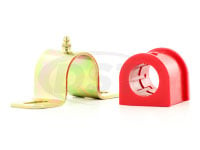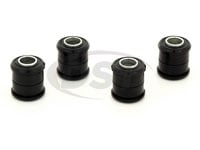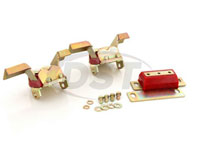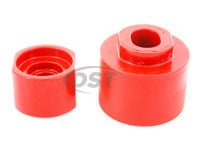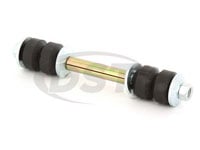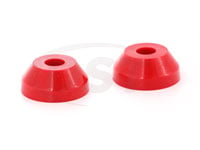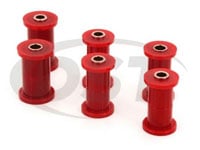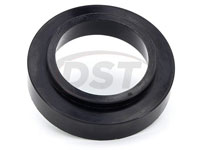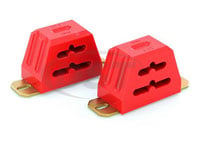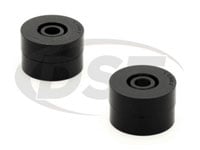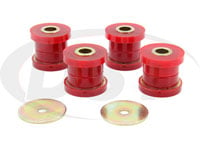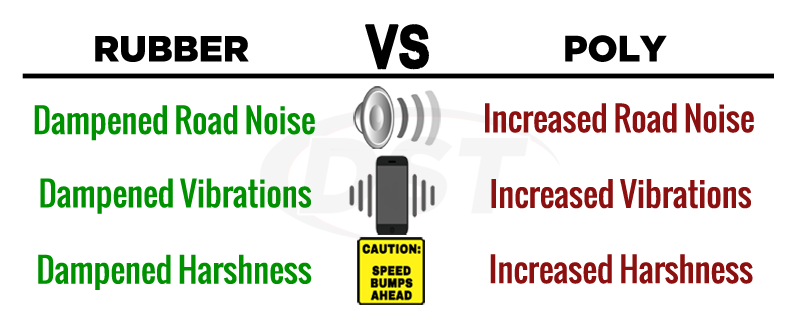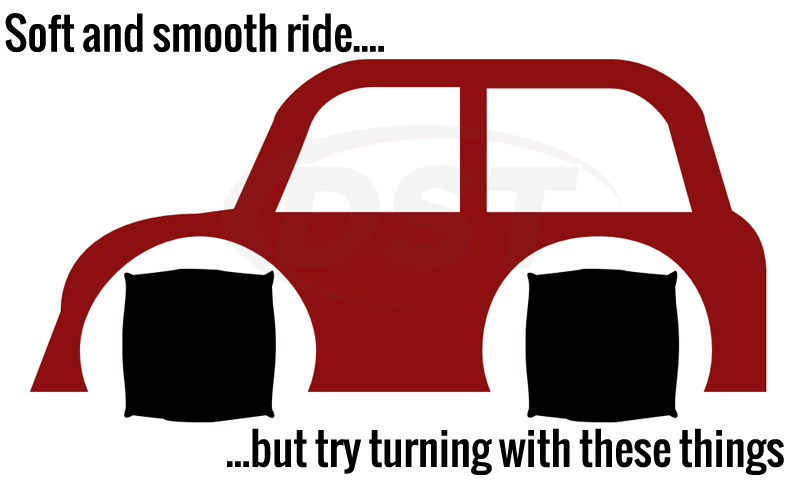Polyurethane Vs Rubber
Specific Suspension Component Breakdown
What actually is the difference between rubber and polyurethane in terms of suspension bushings? For a more general description of rubber vs polyurethane you can check out the article we wrote about the subject. But, it's important to understand exactly how rubber and polyurethane bushings effect your vehicle at specific positions in the suspension.
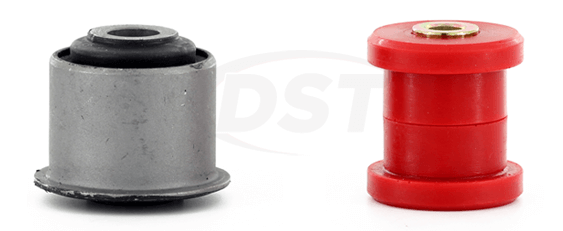
Select the specific suspension component to see a breakdown of polyurethane versus rubber:
Suspension.com
has all the parts you need for your ride.
Sway Bar Bushings
The sway bar bushing holds the sway bar to the frame of the vehicle. The sway bar's job is to maintain as much tire to road contact as possible as the vehicle turns. As the vehicle leans into a turn, the sway bar bushing is compressed and returns to its normal state after the vehicle is level again. Over time, this cycle of compressing takes its toll on a rubber bushing. The center of a rubber sway bar bushing becomes larger as the bushing is warped over time. Once that happens, the rubber sway bar bushing loses its grip on the sway bar which reduces its effectiveness. Not only does this allow the sway bar to flop around and hit other suspension parts, but it also causes an increase in vehicle body roll in turns and diminished handling.
A polyurethane sway bar bushing has a much better grip on the bar and will keep that grip over time. As your vehicle turns, the polyurethane bushing doesn't give like a rubber bushing. This results in decreased body roll and more consistent tire to road contact.
Because a Sway Bar doesn't hold any vehicle weight NVH isn't really an issue here. Which means there isn't necessarily a benefit to using rubber over polyurethane since there is no NVH to dampen. The more rigid nature of a polyurethane bushing provides a tighter grip, giving the sway bar the performance of an even larger bar. Regardless of your choice here be sure to grease the rubber or polyurethane sway bar bushing very well during installation. A sway bar does a lot of moving, and the last thing you want is an non-lubricated bushing holding on to a moving sway bar.
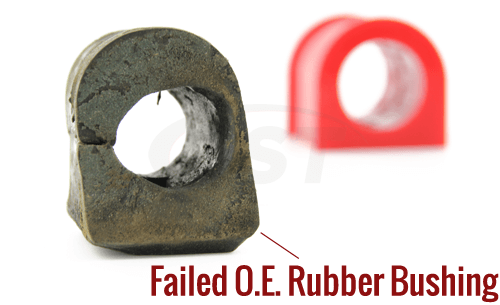
Control Arm Bushings
The control arm bushings play a very important role in the alignment of your suspension. This is why rubber control arm bushings are a pick-your-poison type of part. You can dampen a lot of noise and vibrations from the suspension into the cab with a rubber bushing. But that means a lot of stress will be put on the rubber as the suspension travels. Most of the pressure on a control arm bushing comes in the middle where the center sleeve is. As the control arm pivots, pressure is put on the bushing, keeping the control arm from going too far and returning the control arm to its normal state. Over time the inner part of a rubber bushing, after repeated stretching and flexing, can begin to sag and the "center" sleeve is no longer centered. Once this center point changes, the alignment of the suspension changes. After the center point is changed you'll have to get the vehicle re-aligned to accommodate for the new "center". As the bushing wears down more and more, the rubber bushing will continue to sag leading to yet another change in "center". Because the center of the bushing is continually changing, you'll constantly have to get the vehicle re-aligned. Eventually a rubber bushing can fail completely causing a looseness that can result in a clunking when you turn and go over bumps and an inability to maintain alignment entirely.
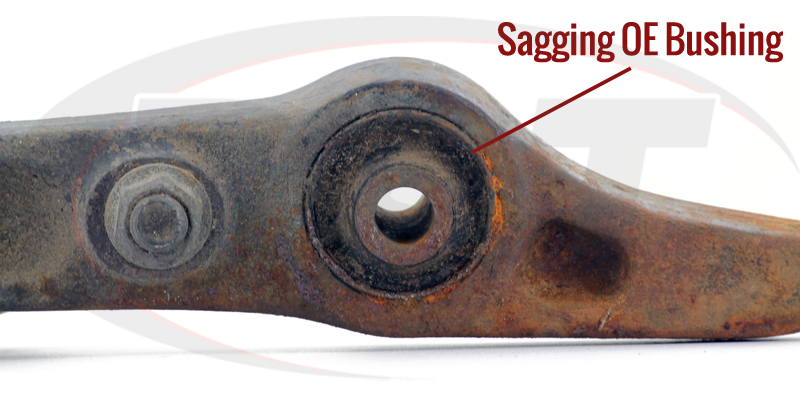
Polyurethane on the other hand is made to handle the stress of control arm movement. The firmer bushing material keeps the control arm movement efficient without the "sag" in the center of the bushing. Not only does this allow the control arm to function as originally designed, but also maintains your alignment. After installing polyurethane bushings (or any new control arm bushing) it is highly recommended to have your vehicle re-aligned. This is because over the years your alignment has been ever changing due to the sagging bushing center. Now that the "center" point of the bushing has been restored, your alignment needs to be returned to OE specs. That's the good news. Here's the bad news. When you change from a soft rubber bushing to a firmer polyurethane bushing, the dampening of vibrations is reduced. Now I'm not saying the car is going to be as harsh as a race car that uses a solid bushing with no dampening, but you should expect a slight increase in NVH. For some folks this increase is unwelcome, but again, it's just a matter of preference. In addition to NVH concerns, you also have to make sure that a polyurethane control arm bushing is greased properly during the install to avoid squeaking. Depending on your driving style and the road conditions in your area, you'll likely want to re-grease your new bushings within 5 years to ensure a squeak free ride.
With a choice between rubber or polyurethane control arm bushings, it comes down to a matter of preference. A replacement rubber bushing will provide you with the same level of NVH dampening that your vehicle had when it was new. But don't be surprised if you have to replace the bushing again several years down the road. Or you can choose a polyurethane bushing for its durability and longevity. While you also get a handling performance boost and a maintained alignment, the firmer material will cause a slight increase in NVH. Its up to you.
Motor and Transmission Mounts
The motor and transmission mounts "mount" the engine and transmission to the frame, respectively. Aside from the obvious function of "mounting" they also dampen vibration from entering the cab of the vehicle. The engine and transmission in a vehicle aren't just sitting there. When you hit the gas pedal they're trying to move themselves around. The mounts dampen the vibration and movement from being felt by the driver.
Rubber mounts do an okay job in dampening vibrations for a while, but eventually wear and crack. Once a mount has deteriorated not only has the mount lost the ability to dampen noise and vibrations, but the threat of misalignment between the engine (transmission) and the frame is now present, which can lead to some performance issues. On higher horsepower vehicles that put out more torque, rubber mounts are even more susceptible to failure. A rubber motor mount works fine for a stock vehicle that isn't driven aggressively. However, if you have a heavy foot or have modified your vehicle to have increased horsepower, those stock rubber mounts will not be up to the task.
Polyurethane motor and transmission mounts attempt to balance the fine line between vibration dampening and durability. If you were a race car driver and didn't care about vibration, you would always go with a solid metal motor mount. But for most drivers, some level of vibration dampening will result in a more driver friendly vehicle. For higher horsepower vehicles, a polyurethane engine mount and transmission mount will hold the proper alignment, not allowing a hindrance to the vehicle's performance.
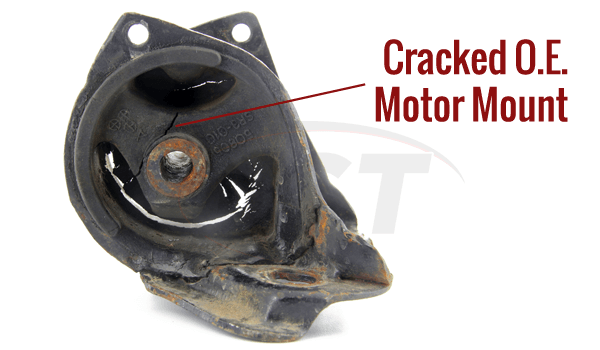
Okay that sounds good, but what does it actually look like? Take the 2012 Ford Mustang for example. A lot of drivers bought this beast to drive it aggressively, but for those who got the MT82 Transmission, they found a problem. When they attempted to shift on corners, the Mustang missed shifts constantly. Why? The Transmission Mount on the Ford Mustang had such large voids that the rubber flexed way too much. This flexing allowed the transmission to move, causing the shifting process to be misaligned leading to the missed shifts. Now the reason for the voided rubber in the first place was to dampen vibration. But in trying to make a smoother ride, the Mustang was limited in its ability to perform. This led some aftermarket polyurethane bushing manufacturers to make a polyurethane insert to fill the voids left in the OE rubber. This insert prevented the transmission from over flexing and becoming misaligned, effectively eliminating the missed shifts! However, without those voids there is now an increase in NVH from the transmission. So its a choice you have to make, which one is more important to you: smoother ride with missed shifts or smooth shifts with an increase in NVH?
So for Motor and Transmission Mounts, when you think about rubber vs polyurethane it's all about what you're looking for in your vehicle. If you're driving a stock car like a grandma, then rubber is probably the best way to go to keep the NVH down. If you have a high horsepower vehicle and drive it aggressively, polyurethane will give you the best performance with a little more NVH. But hey! Either way, at least there isn't an opportunity for squeaking here! There are some positions on your vehicle where greasing a part isn't neccesary, the motor and transmission mounts are two of these points. There is no rubbing between polyurethane and metal here.
Body Mounts
Body to frame mount bushings are typically found on SUVs and Trucks. Think of your vehicle as two separate pieces that are "glued" together. First you have your chassis, or frame, which is the wheels, the suspension, and the "rails" that connect the wheels. Then you have the body which is the top half of the vehicle where you and your passengers sit. The body is set on top of the frame and mounted together. These mounts are known as the body to frame mount bushings.
The OE mounts are made of rubber and are prone to deteriorating and sagging. In extreme cases the mounts can corrode so much that they just fall off. When the body mount bushings fail, the "glue" holding the body and the frame together is now compromised. Think of it like this. The frame is a seat, the body is a boy in 4th grade, and the body to frame bushings are the seat belt. Now you are driving down the road and you hit a speed bump. If the seat belt is working properly, the boy and the seat stay secured together, travelling up and then down without too much problem. Now take that same speed bump but remove the seat belt. Once the vehicle hits the bump the boy is going to bounce off of the seat and then come back down and hit the seat, and depending on your speed, maybe bounce a couple times. While the little boy may enjoy the roller coaster, this is not ideal. When the "seat belt" that holds your body to frame together is gone, hitting a speed bump causes a similar occurrence between your body and frame. Additionally, without the body mounts all working properly, the alignment between the body and the frame is not maintained. This will lead to the panels on your body not lining up properly.
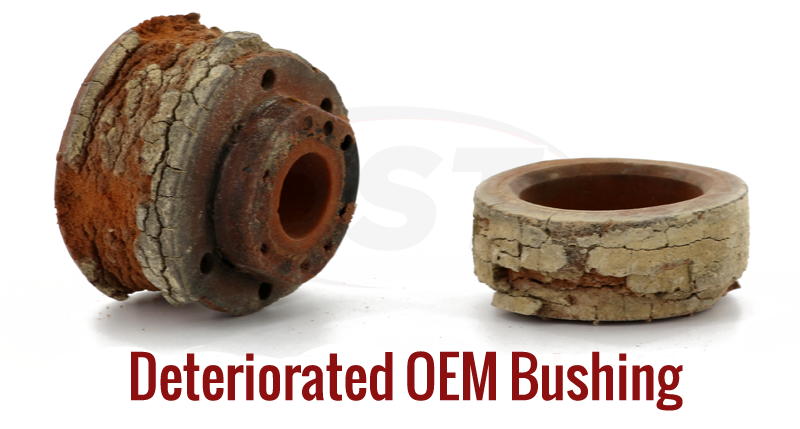
Polyurethane body mounts can survive the beating these bushings take without the corroding part. Also, polyurethane is not affected by road grime or weather so the danger of rotting and cracking is gone. This is another point where grease is not needed and squeaking isn't an issue, because these bushings don't move against metal. Body mount bushings act as a cushion between the body and the frame so there is little movement in the bushing. While you won't have the same soft ride that you had with rubber, polyurethane body mounts offer so much durability that you won't have to replace these again.
Sway Bar End Links
The end link connects the ends of the sway bar to the control arm. Although some vehicles have metal joints, most end links utilize grommets at the attachment points. Rubber grommets are the cheapest way to go, which is what the OE manufacturer often uses. The grommets hold the sway bar securely, allowing the sway bar to work efficiently. Unfortunately, rubber wears out over time leaving the end link loose to move around. Not only does this cause unwanted noise, but it will reduce the effectiveness of your sway bar and its ability to maintain tire to road contact while turning.
Polyurethane end link bushings are really much better for this specific area. NVH is not of real importance here because the end link is not a direct attachment point to the frame. The durability of the polyurethane will ensure that the grip on your sway bar stays tight and your sway bar effectiveness is maintained. As an added plus, this is another one of those points where squeaking isn't an issue and no lubrication is required.
Up until this point, I've tried to stay away from declaring a winner between the two materials. But when it comes to end links, I really don't have an argument as to why rubber is a good option here. There is no NVH threat here or a squeaking threat. So from shear durability and performance, polyurethane is the best choice for this specific area of the suspension.
Dust Boots
Dust boots, while small in appearance, play a large role in the longevity of your suspension. Dust boots are typically found on joints in the suspension, such as a ball joint or tie rod end. The ball joint and tie rod ends have a ball and socket type design, allowing the ends to pivot as the vehicle travels. A dust boot acts as a seal around the joint, keeping in grease and keeping out dust and other harmful road contaminants. If a dust boot cracks, distorts or fails in any way, the joint is now opened up to those dangerous contaminants. You do not want this happening! If a control arm bushing fails you can just replace the bushing without having to replace the entire control arm. But if a dust boot fails, your entire ball joint could fail due to corrosion by contaminants. And in the most extreme cases where the ball joint can't be replaced, you'd have to replace the entire control arm. A rubber dust boot is what comes stock on your joints. Having a super expensive part like your control arm depend on a little rubber piece is risky
Similar to the end link bushings, polyurethane dust boots are a no brainer here. The little elasticity in polyurethane allows them to seat snug on the joint keeping in grease and keeping out any contaminants. The longevity of polyurethane ensures the protection of your joint, helping you to avoid more costly repairs in the near future. This is not a part where squeaking or NVH have any relevance. Securing your joint with a polyurethane dust boot can save you a lot of money down the road.
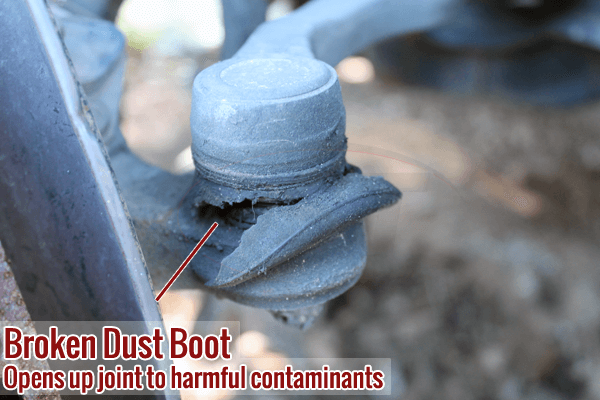
Leaf Spring and Shackle Bushings
A leaf spring is a form of a spring that originally was very common on automobiles and has been around since the medieval times. Back then, leaf springs were made of leather and used on horse carriages. When the automobile first came around, leaf springs were made of steel. Nowadays most automobiles use coil springs instead. However, many vans, trucks and SUVs still use leaf springs in the suspension because of it's superior weight distribution of heavy loads.
Now leaf springs do more than just take the jolt out of the bumps you encounter and weight distribution. They also hold the alignment of the rear axle, controlling the thrust angle of your vehicle. The connection between the axle and the leaf spring is usually bolted metal but the connection points between the leaf spring and the frame are stock rubber bushings. Since the leaf springs are responsible for holding your rear axle to the frame any loosness in the spring-to-frame connection can cause your rear wheels to not point straight ahead (thrust angle).
This can be caused by worn or hollowed out rubber bushings holding the leaf springs to the frame. Imagine the problems this could cause: rear steering, sideways push on the front tires, offset steering wheel. And this isn't really a matter of "if" but "when" this will happen becuase rubber just doesn't last forever. When these bushings fail you have the option of replacing them with more rubber bushings which will give your vehicle the same performance and ride that the original stock bushings did. But, these bushings will probably have the same lifespan as the stock bushings.
If you're looking for a longer-lasting more durable answer, then polyurethane leaf spring bushings are a great replacment option. They are on a different level than rubber when it comes to enduring punishment. Also the heat, road grime, and climate effects that can break rubber down to dust have virtually no affect on polyurethane. Now with polyurethane leaf spring bushings you will notice that your ride is a little stiffer in the back, but you won't have to worry about your leaf springs shifting because of warped or hollow bushings. Polyurethane rides the fine line between durability, performance, and comfort giving you the best possible balance of all three.
So your replacement choice really comes down to a preference. Do you want a smoother feeling back end that will eventually wear out and possibly lead to misaligned thrust angle, or a firm rear axle connection with much more longevity but less NVH reduction?
Coil Spring Isolators
Replacing leaf springs on most automobiles are the Coil Springs. A coil spring is a heavy duty metal bar that has been coiled like a spring. These coil springs compress and then expand absorbing the motion of the tires as the suspension travels. Sitting on the top and bottom of your coil springs is an isolator, mounting the coil spring in between the control arms. This isolator is responsible for dampening the noise and vibrations from the coil spring. Without an isolator not only will you see a lot more NVH, but your ride height will also be changed.
What commonly comes stock on the majority of coil springs are a pair of rubber coil spring isolators. The rubber isolator does a good job dampening the noise and vibration so that the driver and passengers are unaware. However, over time as the rubber deteriorates and warps the once smooth and quiet ride will begin seeing an increase in noise and rough rides. Also with the warping rubber comes a change in ride height of the vehicle. A suspension is set up at a certain height, and when that height changes your springs are in danger of potential damage. Plus, the sound of a metal coil spring against a metal control arm isn't very peaceful either.
A polyurethane coil spring isolator restores the ride height of the vehicle and is immune to deteriorating or warping. The firmer polyurethane isolator does lead to an increase in NVH. Here the decision comes down to driver's preference. You can go for a smoother and quieter ride with a rubber isolator, knowing that you may have to replace it again in the future. Or, you can choose a much more durable part in polyurethane with an increase in NVH.
Motor and Transmission Mounts
A Bump Stop does exactly what you think it does, stops the bump. Well, it's a little more detailed than that. The functions of a bump stop are to limit suspension travel so that tires don't rub on the body, to prevent the vehicle from bottoming out, and to prevent the over-compression of springs. A stock bump stop is usually made of rubber and takes on various shapes across vehicle application. This piece is designed to take impact. With what we already know about the soft rubber material, that is not a recipe for success. After repeat abuse, these rubber bump stops begin to turn to mush. That's if they don't corrode before hand. Bump stops are located on the underside of the vehicle and are exposed to the elements, vehicle oils, and road grime, all of which lead to the deterioration of rubber. Once a bump stop has failed, your vehicle is now susceptible to bottoming out and there is nothing to stop the tires from rising up to rub the wheel well as you go over bumps.
This is another one of those suspension pieces that polyurethane is really the best way to go. Not only is polyurethane not affected by the elements or vehicle oils, but the material is much stronger and is designed to take the repeated abuse without changing the shape of the bump stop. Since a bump stop does not hold any vehicle weight, NVH is not an issue here. As and added bonus, a bump stop doesn't squeak, so no grease or worry required.
Shock Mount Bushings
The rubber piece that you find where the bottom of your shock is mounting to the control arm is a shock mount bushing. The majority of OE manufacturers use a rubber bushing for this mounting point. The bushing here plays an important role in dampening noise and in the longevity of your shock. If the bushing fails or the center point of the bushing changes due to sagging, you will experience an annoying clunking sound and the alignment of your shocks can change internally. This puts more pressure on the pistons inside the shock. Over time that pressure on the piston causes the entire shock assembly to fail, all because the bushing wasn't up to par.
Replacing this failed bushing with a rubber shock mount bushing is a good news, bad news situation. The good news is the softer rubber will dampen the noise and vibrations from entering the cab. The bad news is a rubber bushing is what failed in the first place. So it shouldn't come as a surprise if you have to replace this bushing again in the future to avoid damage to your shock.
A polyurethane shock mount bushing provides you with longevity and the peace of mind knowing that you shouldn't have to replace that bushing again. Polyurethane bushings are made to be firmer than rubber and have a very low failure rate. The flip side of this is more NVH can be transferred into the cab. Polyurethane doesn't dampen NVH at the same level of rubber, but the trade off for durability is worth it to some people. You must make sure you grease the bushing properly at install to avoid squeaking.
Losing an entire shock assembly to a small bushing is a nightmare. So whether you choose rubber or polyurethane, be sure to replace that bushing if you notice a clunking coming from your shocks. You have a choice here between a noise dampening rubber bushing that has a high failure rate, or a firmer more durable polyurethane bushing that can slightly increase your NVH.
Differential Bushings
When you slam on the gas, the engine sends power down the drive shaft towards the differential. The differential divides the power to the wheels, which causes the wheels to turn and the vehicle to move. Also, the differential is set up in a series of gears, allowing each tire to spin at a different rate, which is important during turns. Now what happens when the wheel begins to spin, but the tires have less than ideal traction? You're not going anywhere. Or worse, you get wheel hop. Wheel hop is a huge pain when the stop light turns green on a city road, and is even more dreadful on a strip of concrete when you're launching. One of the factors that can cause reduced power to tires, and wheel hop, is failed differential bushings. Differential bushings are what holds the differential to the frame of the vehicle. In order to achieve maximum effectiveness in the differential, it cannot be moving around. When you slam on the gas, or slam on the brakes, gravity comes in and the differential wants to either dive forward or fall back. Considering this is the part that supplies power to the wheels, you don't want any ineffectiveness here.
The stock OE differential bushings are made of rubber, a soft material for bushings. The biggest, and only real benefit to rubber is NVH dampening. The differential receives a lot of power from the engine to make your wheels turn. With that power comes noise and vibrations, which the rubber bushing dampens so that it's not transmitted to the frame and into the cab. The issue with the soft rubber bushing comes with its susceptibility to failure. A rubber bushing tends to flex under pressure and when flexing happens, the differential can move. When the differential moves, your tire traction suffers. Not only does a rubber bushing flex, but over time the rubber can wear and crack. The worse off the bushing gets, the more your differential can move around when accelerating or decelerating, decreasing the efficiency of your braking and slowing down your launch.
A polyurethane differential bushing on the other hand provides much more durability and stability in keeping the differential from excess movement. Without the excess differential movement, more power is transferred to your wheels. More power to the tires equals better traction and faster acceleration. The flip side is also helped, as the differential is kept from diving, increasing the efficiency of your braking. A polyurethane bushing is engineered to be firmer than the rubber bushing, so less dampening of noise and vibrations is likely. This will send more NVH to the frame and into the cab. Again, not as much vibrations and noise as a solid mount on a race car. But it is a slight increase over the stock rubber.
The choice of material for a differential bushing again comes down to driver preference and what your driving style is like. If you have a lead foot and like to drive aggressively, a polyurethane differential bushing will allow you to get more power to your tires at the expense of dampened NVH. But if you are just driving to and from work and are usually not in a hurry when the light turns green, the NVH dampening rubber is probably a better fit. But be careful with rubber. If you leave a failed rubber bushing installed too long you may be dealing with a much more costly repair down the road, replacing a failed differential.
Subframe Bushings
For uni-body vehicles, the subframe acts as the mounting point for suspension parts. The subframe bushings are found at mounting points between the subframe and the body. When subframe bushings fail, noise and vibration become major annoyances for the driver and passengers. It's kind of a double edged sword as well, because when a subframe bushing fails not only do you experience the noise and vibrations from the subframe and body,but there is no bushing to dampen the noise traveling from your suspension parts, through the subframe, and into the vehicle cab. NVH isn't the only negative to a failed subframe bushing. Without the bushing holding the subframe in place, your vehicle will experience unpredictable handling and slower launch times due to the dreaded wheel hop.
Replacing subframe bushings with rubber replacements will return your ride to its original noise and vibration level. The rubber material is soft, acting as a noise and vibration dampener. However, the OE manufacturer used rubber in the stock subframe bushings, so don't be to surprised if you have to replace the rubber bushings again several years later. Rubber breaks down over time either by wear and tear, or by road chemicals and oils. While rubber certainly does a good job in dampening NVH, be mindful of rubber's negatives. After all, if rubber failed the first time it's safe to assume it'll fail again.
There is also the choice of replacing those failed subframe bushings with polyurethane. Polyurethane subframe bushings are made to be firmer than the stock rubber. The firmer material adds durability and longevity to the bushing, ensuring you won't have to replace the bushing again. Just like rubber though, polyurethane has it's no so good traits at the subframe. A firmer material means less dampening and an increase in NVH. Durability and NVH are not the only areas that a polyurethane bushing will have an immediate impact. With a polyurethane subframe bushing, you gain more predictable handling and, most importantly, you eliminate the chance of wheel hop, giving you a faster and smoother launch out of the hole. And a faster and smoother launch is ideal whether your on a drag strip or at a green light.
Subframe bushings are vital. You don't want to be running on failed subframe bushings for too long and risk damage to your suspension components or the subframe itself. Your choice of replacements here (unless you want to go with a solid mount and get no dampening at all) are rubber and polyurethane. Each material has its pro's and con's. It's all up to what you as the driver prefers. An NVH dampening bushing that you'll more than likely need to replace again in a few years (rubber) or a firmer, more durable bushing that gives you longevity with an increase in NVH (polyurethane). You be the judge.
